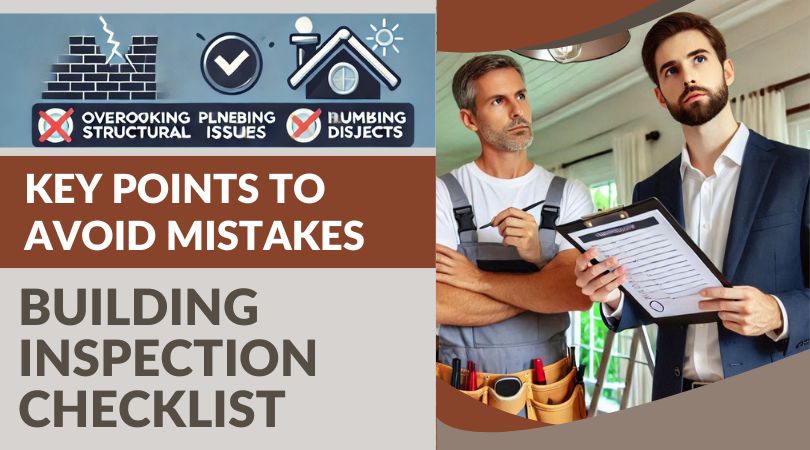Building Inspection Checklist: Key Points to Avoid Mistakes
When buying or maintaining a property, a building inspection checklist is essential. It helps identify potential issues early, preventing expensive repairs. A well-structured checklist covers structural integrity, electrical systems, plumbing, and safety compliance, ensuring buyers and owners make informed decisions. Neglecting key inspection points can lead to significant financial losses and legal troubles.
Why a Building Inspection Checklist Matters
A thorough property inspection uncovers hidden damages that may not be immediately visible. Buyers often encounter unexpected expenses due to faulty wiring, plumbing issues, or foundation problems. Using a building inspection checklist ensures early detection of these issues, saving both time and money.
Benefits of a Detailed Building Inspection
- Identifies Structural Issues: Evaluates the foundation, walls, and roof for stability.
- Detects Safety Hazards: Finds fire risks, faulty electrical systems, and leaks.
- Ensures Legal Compliance: Confirms adherence to local building codes.
- Prevents Hidden Costs: Avoids unforeseen repair expenses.
- Increases Property Value: A well-maintained home attracts buyers and sells faster.
Essential Points in a Building Inspection Checklist

-
Structural Integrity
Check the foundation, walls, and roof for cracks, water damage, or shifting. Weak structures require immediate attention to avoid costly repairs.
-
Roof Condition
A damaged roof can lead to leaks, mold, and insulation problems. Inspect for:
- Missing or broken shingles
- Water stains on ceilings
- Clogged gutters and poor drainage
- Mold or mildew growth
- Sagging or structural damage
-
Electrical Systems
Faulty wiring can be a fire hazard and lead to high electricity bills. Assess:
- Circuit breakers and fuses
- Overall wiring condition
- Power outlets and lighting functionality
- Safety switches (GFCIs)
- Signs of overloaded circuits
-
Plumbing
Leaks and poor drainage can cause significant damage. Check:
- Dripping faucets and leaking pipes
- Water pressure levels
- Signs of mold near pipes
- Rust or corrosion in plumbing systems
- Water heater efficiency
-
Heating and Cooling Systems
Ensure the HVAC system operates efficiently. Inspect:
- Air filters and ducts
- Thermostat function
- Unusual noises or odors
- Energy efficiency
- Proper ventilation
-
Pest Infestation
Termites, rodents, and insects can damage the property. Look for:
- Wood damage or termite tunnels
- Small holes or cracks allowing pests inside
- Rodent droppings
- Presence of wasp nests or insect colonies
- Strange smells indicating infestations
-
Fire Safety
Fire hazards must be eliminated to ensure compliance. Check:
- Smoke detectors and fire alarms
- Fire extinguishers
- Clear and accessible emergency exits
- Carbon monoxide detectors
- Use of fire-resistant materials
-
Moisture and Mold
Excess moisture leads to mold growth, impacting air quality. Inspect:
- Musty odors
- Peeling or bubbling paint
- Water stains on ceilings and walls
- Proper ventilation in high-humidity areas
- Basement dampness
-
Doors and Windows
Faulty doors and windows compromise security and insulation. Ensure:
- Secure locks and sturdy handles
- Proper sealing and weatherproofing
- Smooth opening and closing
- Energy-efficient glass installation
- Absence of wood rot in frames
-
Exterior and Landscaping
A well-maintained exterior prevents future structural issues. Evaluate:
- Cracks in driveways or walkways
- Drainage effectiveness
- Stability of fences and walls
- Tree health and potential risks
- Condition of exterior paint and siding
-
Insulation and Energy Efficiency
Good insulation reduces energy costs. Inspect:
- Proper attic and wall insulation
- Energy-efficient windows and doors
- HVAC system efficiency
- Sealed vents and pipes
- Solar panel functionality (if applicable)
-
Foundation and Drainage
A weak foundation leads to severe property damage. Examine:
- Cracks in walls, floors, or foundation
- Water pooling near the property
- Functioning gutters and downspouts
- Basement stability
- Adequate water runoff systems
Common Inspection Mistakes to Avoid

-
Skipping a Professional Inspection
Some buyers believe they can inspect a property themselves. However, certified inspectors have the expertise to identify hidden defects. A professional report provides valuable insights for better decision-making.
-
Ignoring Small Problems
Minor leaks, cracks, or faulty wiring may seem insignificant but can lead to major repairs. Addressing these early prevents costly consequences.
-
Overlooking the Attic and Basement
These areas often hide pest infestations, water damage, and insulation issues. Checking them thoroughly can prevent future surprises.
-
Not Checking Permits and Compliance
Unapproved renovations can violate local building codes, leading to fines or mandatory corrections. Always verify permits for past modifications.
-
Rushing the Inspection
A quick inspection may overlook critical defects. Take time for a detailed evaluation to ensure a well-informed purchase.
-
Forgetting Notes and Photos
Documenting findings with notes and pictures helps track required repairs and supports negotiations with the seller.
-
Neglecting Environmental Hazards
Check for asbestos, radon, or lead-based paint to avoid health risks. Specialized tests can confirm property safety.
-
Not Reviewing Past Repairs
Previous repairs may not always meet safety standards. Ensure past work was done correctly to prevent future problems.
Conclusion
A building inspection checklist is a vital tool for buyers, sellers, and property owners. It prevents costly mistakes, ensures safety, and maintains property value. A thorough inspection can reveal hidden risks and help meet legal requirements.
By following this checklist, you safeguard your investment and gain peace of mind. If unsure, hiring a certified inspector is always a smart choice. Regular inspections lead to better-maintained properties and higher resale value, making them an essential part of property ownership.
Whether you’re buying, selling, or maintaining a home, keeping a building inspection checklist handy helps you avoid financial pitfalls and ensures a safe living space.






